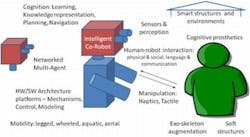National Robotics Initiative program solicitation includes opportunities for machine vision
The National Robotics Initiative (NRI), announced last week by President Obama as part of theAdvanced Manuacturing Partnership, has issued its Program Solicitation for "The realization of co-robots acting in direct support of individuals and groups." It is available on the website of the National Science Foundation (NSF), which serves as the coordinating body for the Partnership. Opportunities for machine vision in co-robots--also known as service robots--can also be found in the recent report from Vision Systems Design titled Vision for Service Robots: Current and emerging technologies, applications, and markets, or in the brochure for the report.
The opportunities and challenges for the NRI were first published in a 2009 report titled A Roadmap for US Robotics--From Internet to Robotics. The report suggests ways in which robots in the future can serve as co-workers, co-protectors, and co-inhabitants. This report and others have pointed to the lack of a national policy to help the US compete in robotics against other nations, many of which have formed more cohesive policies supporting the development of both industrial and nonindustrial (ie, service) robots.
Some of the primary vision technologies used in service robots are structured-light systems, two-camera stereo systems, time-of-flight sensors, lidar, and single-lens camera systems. In addition, other sensing/locating technologies may be combined with vision components to provide even more information to the robots, including GPS navigation, radar, sonar, and inertial guidance. A technique known as simultaneous localization and mapping (SLAM) is critical to build maps of unknown environments or to update maps within known environments, while at the same time keeping track of the current location of the robot.
NRI Goals
The NSF, along with NASA, the National Institutes of Health (NIH), and the US Department of Agriculture (USDA) have pledged to advance the science and engineering of co-robotic systems that safely co-exist in close proximity to humans in the pursuit of mundane, dangerous, precise, or expensive tasks.
"The primary purpose of this cross-agency initiative is to provide US leadership in science and engineering research and education aimed at the development of the next generation robotics," said Farnam Jahanian, NSF's Assistant Director for the Computer and Information Science and Engineering (CISE) Directorate. "We have barely tapped the potential for devices and instrumented environments that augment human mobility, manipulation, perception, and cognition in jobs ranging from those in the factory and office to those involved in the management and execution of search, rescue and recovery activities during emergencies and natural disasters."
He says it is increasingly evident that early stage co-robots are a harbinger of numerous, large-scale, global robotics technology markets likely to develop in the coming decades. NRI will focus on fundamental research and education by academia and industry, seeking to engage the next generation of scientists and engineers in fields essential to the new global technology economy.
Agencies and funding
Investments in NRI from NASA, NIH, NSF, and the USDA may reach $40 to $50 million in the first year with anticipated growth in funding as other agencies and industry partners are engaged.
"NASA has been focused on human-robotic interaction for more than a decade, leading to flight of our newest crewmember on the International Space Station, Robonaut2," said NASA's Chief Technologist Bobby Braun. "Our challenge today is to develop robotics technology that can increase the effectiveness and safety of humans in space and deliver cutting-edge science. Through our participation in the National Robotics Initiative, NASA will create the new knowledge, technology and capabilities needed for our future space missions while benefiting life here on Earth, today."
NIH has used robotics for DNA sequencing, the rapid screening of potential drugs and the subsequent discovery of new drugs. NIH anticipates robotics will play an important role in rehabilitation, home health care, and advanced robotic surgery in the near future.
The USDA encourages automated systems and improved robotics for inspection, sorting, processing or handling of animal or plant products, as well as multi-modal and rapid sensing systems for detecting defects, ripeness, physical damage, microbial contamination, size, shape and other quality attributes of such products.
The image below shows the NRI Technology Space, which represents the breadth of fundamental robotics research to be pursued.
--Posted by Conard Holton
Vision Systems Design
